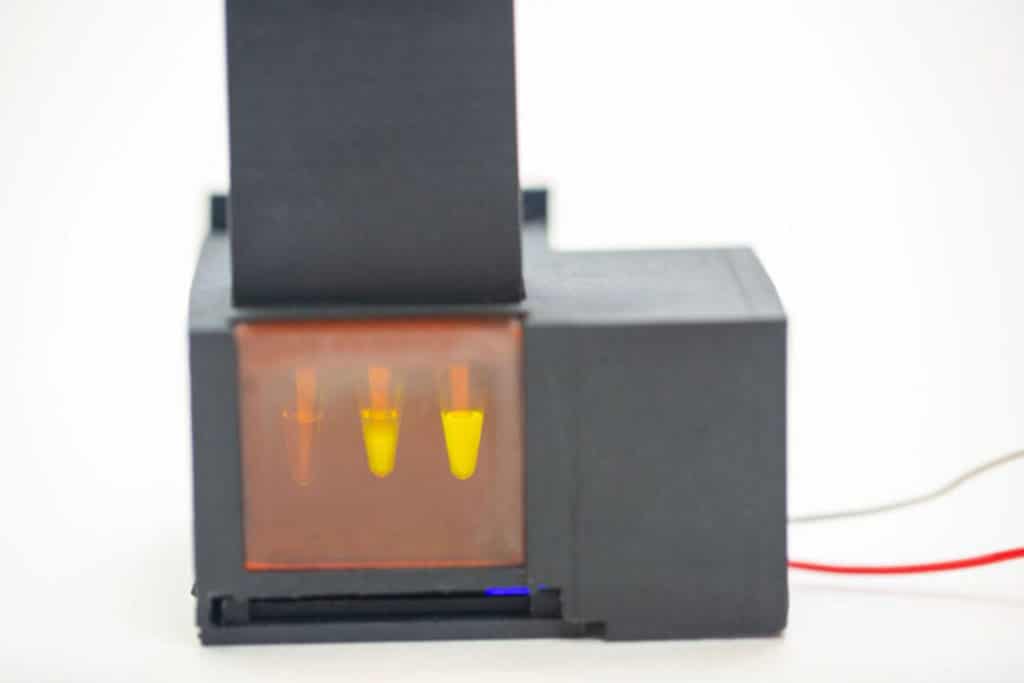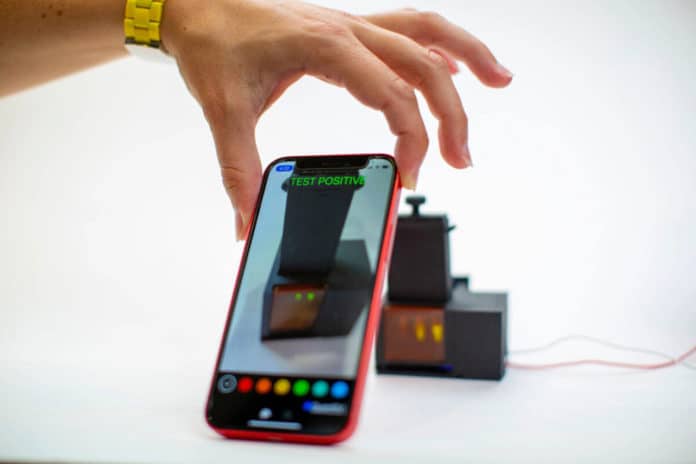Scientists from the Wyss Institute for Biologically Inspired Engineering at Harvard University, in collaboration with several Boston-area hospitals, have created a new COVID-19 detection test called Minimally Instrumented SHERLOCK (miSHERLOCK). miSHERLOCK is an ‘at-home-test’ that is easy to use, inexpensive, and shows results within an hour.
This new COVID-19 testing is a CRISPR-based diagnostic test. Users can test themselves at home by using just a sample of their saliva.
During experiments, the test was able to detect three different variants of SARS-CoV-2. The device can be assembled using a 3D printer and commonly available components.
Co-first author Helena de Puig, a postdoctoral fellow at the Wyss Institute and MIT, said, “miSHERLOCK eliminates the need to transport patient samples to a centralized testing location and greatly simplifies the sample preparation steps, giving patients and doctors a faster, more accurate picture of individual and community health, which is critical during an evolving pandemic.”
Co-first author Rose Lee said, “Simple things that used to be ubiquitous in the hospital, like nasopharyngeal swabs, were suddenly hard to get, so routine sample processing procedures were disrupted, which is a big problem in a pandemic setting. Our team’s motivation for this project was to eliminate these bottlenecks and provide accurate diagnostics for COVID-19 with less reliance on global supply chains, and also accurately detect the variants that were starting to emerge.”
For this test, scientists used a CRISPR-based technology called ‘specific high sensitivity enzymatic reporter unlocking’ (SHERLOCK). SHERLOCK uses CRISPR’s molecular scissors to snip DNA or RNA at specific locations. An additional benefit of this technology: this particular type of scissors also cuts other pieces of DNA in the surrounding area, allowing it to be engineered with nucleic acid probe molecules to produce a signal indicating that the target has been successfully cut.

Scientists created a SHERLOCK reaction designed to cut SARS-CoV-2 RNA at a specific region of a gene called Nucleoprotein that is conserved across multiple variants of the virus. When the molecular scissors — an enzyme called Cas12a — successfully bind to and cut the nucleoprotein gene, single-stranded DNA probes are also cut, producing a fluorescent signal.
They also created additional SHERLOCK assays to target a panel of viral mutations in Spike protein sequences that represent three SARS-CoV-2 genetic variants: Alpha, Beta, and Gamma.
Instead of using nasopharyngeal swab samples as a collection method, scientists chose to use saliva as it is easier for users to collect saliva.
Saliva, however, in unprocessed form, presents challenges of its own: It contains enzymes that degrade various molecules, producing a high rate of false positives. Scientists developed a novel technique to solve this problem: they added two chemicals called DTT and EGTA to saliva. They then heated the sample to 95°C for 3 minutes, eliminating the false-positive signal from the untreated saliva and slicing any viral particles. After that, they added a porous membrane to the SHERLOCK reaction to generate a result.
Scientists also created a simple battery-powered device to integrate the saliva sample prep and the SHERLOCK reaction into one diagnostic. The device had two chambers: a heated sample prep chamber and an unheated reaction chamber.
A user needs to spits into the sample prep chamber, turn on the heat, and wait three to six minutes for the saliva to be wicked into the filter. Then the user needs to remove the filter and transfers it to the reaction chamber column, then pushes a plunger that deposits the filter into the chamber and punctures a water reservoir to activate the SHERLOCK reaction.
After fifty-five minutes, the user needs to look through the tinted transilluminator window into the reaction chamber and confirm a fluorescent signal’s presence. They can also use an accompanying smartphone app that analyzes the pixels registered by the smartphone’s camera to provide a clear positive or negative diagnosis.
This new COVID-19 testing method was tested on 27 COVID-19 patients and 21 healthy patients. It was found that miSHERLOCK correctly identified COVID-19-positive patients 96 percent and patients without the disease 95 percent of the time. It also shows the type of variant and found to be effective across a range of viral RNA concentrations.
Co-first author Devora Najjar, a research assistant at the MIT Media Lab, said, “One of the great things about miSHERLOCK is that it’s entirely modular. The device is separate from the assays, so you can plug in different assays for the specific sequence of RNA or DNA you’re trying to detect. Assays for new targets can be created in about two weeks, enabling the rapid development of tests for new variants of COVID-19 and other diseases.”
Journal Reference:
- Helena de Puig et al. Minimally instrumented SHERLOCK (miSHERLOCK) for CRISPR-based point-of-care diagnosis of SARS-CoV-2 and emerging variants. DOI: 10.1126/sciadv.abh2944
